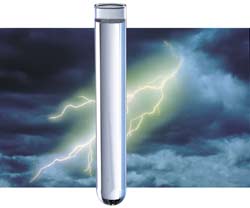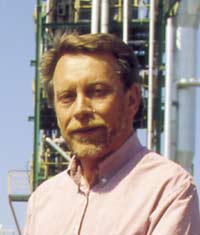
Streaming Electrification (SE) and Electrostatic Charging Tendency (ECT) are phenomena that have been studied for several decades. It is vital that both are minimized because SE can lead to discharges harmful to both installations and people, and quality of the transformer oil in terms of its ECT is one of several key factors affecting SE levels.
Streaming Electrification arises when electrostatic tension builds up as a result of the oil moving in the channels of the transformer and becoming positively charged in opposition to the negatively charged fixed structures. SE is therefore not affected by the normal electrical activity in the transformer, i.e. the conversion of electric current.
Several of the factors that affect SE are directly related to the design of the transformer. The speed at which the oil is pumped around the transformer, the shape of the channels and surface properties all influence SE, as does water content in the oil and the paper. Humidity is generally highly undesirable, but when every effort has been made to keep the oil and the paper very dry, the risk of SE increases.
Operating conditions also play an important role in reduction of SE. For instance, risk of SE increases at high temperatures. One might want to reduce the temperature in a transformer by increasing the speed of flow of the oil, but this also increases the risk of SE. If a transformer is to function in a warm climate the demands on design and the quality of the oil are very high.
Oil quality is vital
Through improvements in design, the transformers of the future can be better equipped to combat SE, but when looking at SE in existing transformers, it is above all through the quality of the oil that the problem can be tackled.
The presence of polar molecules has the greatest influence on the oil’s SE resisting properties (ECT). The greater the quantity of such particles, the greater is the tendency for electrostatic charges to build up between the oil and its surroundings.
In new oil it is easy to measure the content of polar molecules. It is also easy to produce a new oil with a suitable content of polar substances. In a transformer, however, it is not the properties of new oil that are of primary interest. The oil must carry on working for several decades. It is the oil’s ability to resist oxidation that is most important in the long run because impurities are formed during oxidation with strong polar characteristics that will give the oil an increased ECT and therefore greater SE.
Complex composition
Mineral oils have a complex composition consisting mostly of hydrocarbons, which can consist of molecules with straight chains (paraffins), rings without double bonds (naphthenes) and/or rings with double bonds (aromatics). There are also molecules in oil that contain atoms other than carbon and hydrogen, such as sulphur, nitrogen and oxygen. These atoms are called heteroatoms.
If these groups of molecules were negatively charged it would be fairly easy to remove them during refining. But molecules with heteroatoms and many aromatic rings are generally more polar than other hydrocarbons. With very severe refining methods all such molecules can be changed to molecules with only paraffins and naphthenes. The result would be an oil with excellent properties initially, but which would quickly oxidize.
If the oil were not refined at all it would be bad to start with and soon become even worse.
Some molecules with several aromatic rings and containing heteroatoms are highly reactive, oxidize fast and speed up the oxidation of other substances. Other molecules are efficient inhibitors and curtail the processes that lead to further molecules oxidizing.

Various methods
There are different ways of dealing with this problem. One can choose to remove all molecules affecting the oxidation of other substances and then add an effective inhibitor. This is a relatively simple method. A more complex route to the same end involves designing the refining process to remove substances that encourage oxidation while retaining natural inhibitors.
In some sections of the transformer oil market there is a distrust of oils that contain added inhibitors because additives can be used to hide the fact that a product is inferior. All is well only for as long as the additive continues to function, but when it has been used up the oil can show very poor properties. It may contain oxidation promoting molecules whose properties are masked by the added inhibitor. Oil that functions without additives must, on the other hand, be well made and have a well balanced composition.
During refining, hydrogen is added under controlled conditions of pressure, temperature, time and choice of catalyst. Each and every condition can be varied and the combination of conditions determines the outcome.
Endless combinations
The number of possible combinations of these conditions is virtually endless. But a process can be designed to give a good product by drawing on experience of refining technology and knowledge of the various compounds’ properties with regard to oxidation. A good product is an oil that retains as much natural inhibitor as possible with a minimum quantity of substances that accelerate oxidation.
A transformer oil with such a composition is considered to be a good product. But could it be bettered with the addition of extra inhibitors? Generally, no product is so good that it cannot be improved. However, it is most important to ensure the oil has the right properties to begin with before addition of inhibitors is considered. If it has, then properties can be strengthened. The results will not be good whatever is added if initial properties are inadequate.
To avoid the risk of SE, it is important to use an oil that has been refined in a good way, to have moderate flow speeds in the transformers, which is largely a matter of design, and to operate a good transformer oil maintenance system.








